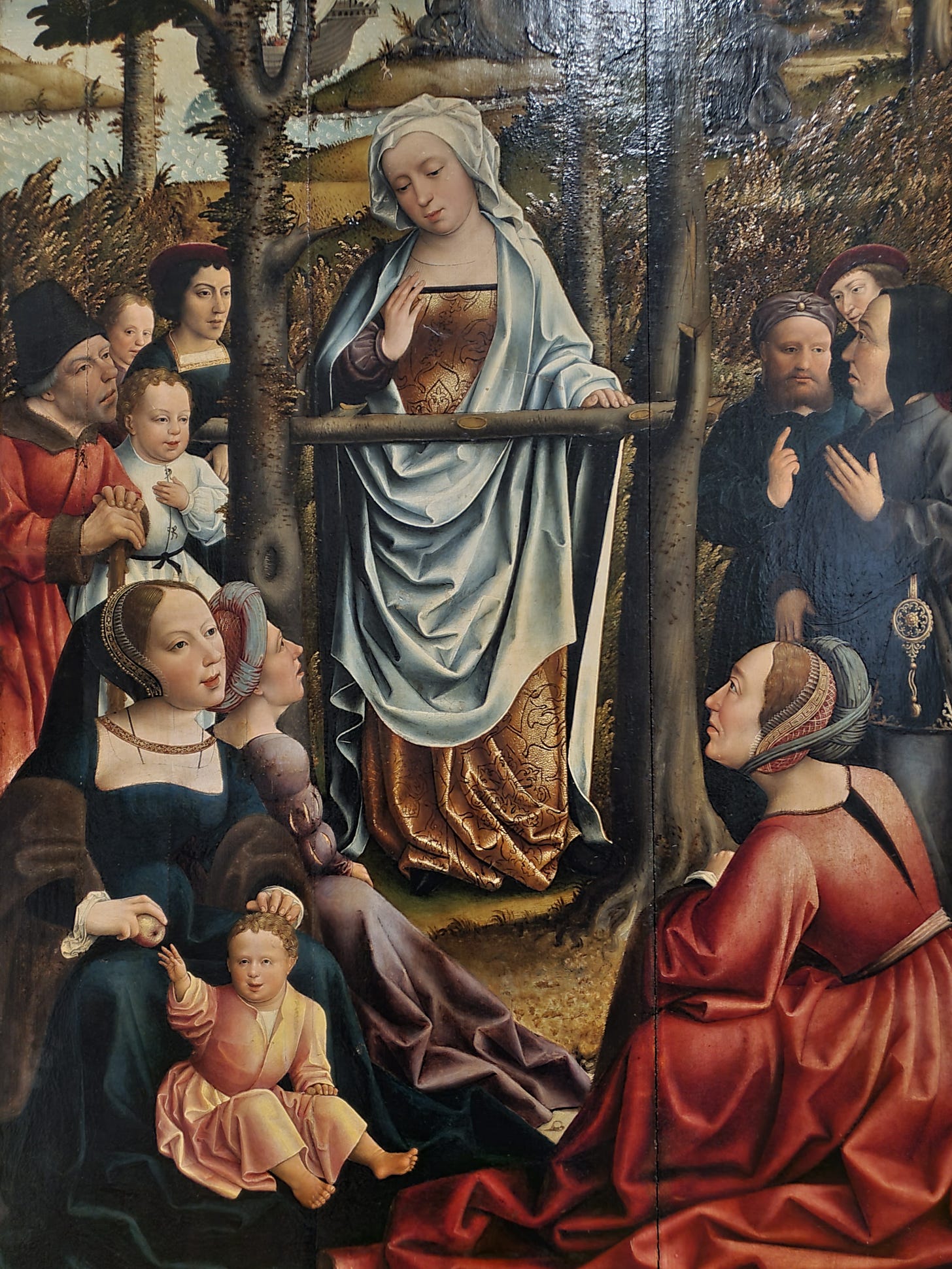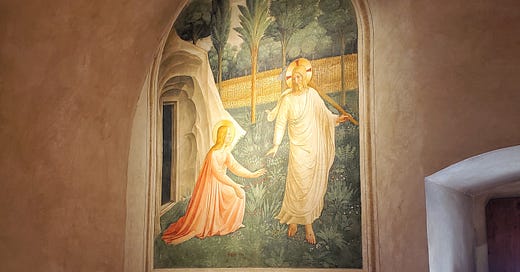For the past few days on my Instagram I have posted pictures of frescoes in the Convent of St. Mark in Florence. It's a jewel box of some of the greatest works of art and easily one of the highlights of my trip to Italy last July. My favorite piece in the collection was painted in the simple cell of a Dominican Friar. It is called Noli Me Tangere, from the Latin for “Do not touch me”. It was painted by the Dominican Friar Fra Angelico and it captures the moment when Mary Magdalen realizes that the gardener whom she thought stole Jesus's body was in fact, the risen Christ himself. I am particularly fond of this fresco because it captures what our faith is all about, an encounter with Christ. Catholicism is a sacramental faith, not simply in the sense that we believe in seven sacraments but that we believe that God can work through visible and tangible things to reveal himself to us in a deeply intimate and personal way.
In western art Mary Magdalen is nearly always depicted kneeling. Much of this is due the fact that in the middle ages Mary of Bethany, Magdalen and the sinful woman were thought to be one person. Therefore Mary was associated with the woman kneeling at the foot of Jesus saved from those seeking to stone her for adultery, at Christ's side at the house of Bethany, anointing him with oils and at the cross. Regardless of your position it's crucial for understanding this view to see the genius of Fra Angelico's fresco. Here we see Mary attempting to kneel and embrace her Lord, an action which she has done time and time again. However, Christ tells her “do not touch me” and to tell the apostles and to announce the joy of Christ's resurrection to his disciples. Through every encounter with Christ we are challenged, this is unanimously true for all the instances of the appearance of Christ after the resurrection, in each encounter he challenges those he appears to proclaim the resurrection, through revealing himself in intimately meaningful ways. Through the breaking of bread, touching of wounds, the calling of a man, an empty tomb or a locked room. Moreover it's through these actions which inspire the apostles to evangelize with such zeal to the point it cost them their lives.

In the Philadelphia Museum of Art, there is an extremely unique depiction of Mary Magdalene preaching in France, where according to medieval legend Mary Magdalene and Lazarus lived after Christ died. I find this difficult to believe, however, when reflecting on the image I imagine Magdalen before the apostles hidden away in a room in trembling fear as Mary comes and announces the resurrection with joy and exaltation. I imagine her saying those words from the Easter Sequence “Yes, Christ my hope has arisen!”.
I mentioned in a previous post that the Redemptorists have chosen as their theme for the next six years ``Missionaries of Hope walking in the Footsteps of the Redeemer '', this is a theme I believe is fit for all the Church. Just as Christ called Magdalen to be a Missionary of Hope on that serene Easter morning, so too does she call each of her baptized children to encounter and joyfully announce that we believe in a risen God, who destroyed the kingdom of death. However, in order to do this we must truly encounter the resurrected Christ and be overcome with paschal joy.
After Mass on Easter Morning I went to Central Park. Easter Sunday was a beautiful day and the park was filled with people enjoying the freshly sprung flowers and newly blooming trees. I was reminded of a quote from the liturgist Pius Parsch ``Spring is nature's Easter Liturgy”, it's true all of creation seems to proclaim the glory of redemption, everything great and small seems to ring out alleluia! I love how during the octave we respond to the dismissal at the end of Mass with Thanks be to God Alleluia! Alleluia! It gets to the point of what the Mass means, it's to be sent forth, sent forth into this wounded world to proclaim Alleluia Christ has risen and to truly be Easter people.
While walking through Central Park I reflected on Fra Angelico's fresco and what that first Easter Sunday must've been like. Despite its beauty and the warm glow of the dawning sun, how devastated Mary Magdalen must've been going to the tomb, the confusion of seeing the angels, then her anger at the gardener for taking the body and finally the joy of realizing that the gardener was Christ. How the beauty of the world around her was unveiled through the sunlight, the flowers and trees and the marks in Christ's hands and feet. Daily, we encounter Christ through all the beautiful things which he has made for us. In the glory of nature, in the sacraments, in art, music or even in a simple smile, a stranger, a gardener. Those special moments of encounter, when we realize God is present, loves and calls us are moments of grace.
Lastly, a small detail you likely didn't notice, the small red flowers by Christ’s feet. Some art historians have theorized that these are supposed to symbolize the blood of the passion connecting the passion to the resurrection. Looking at this fresco in this lens has clear eucharistic undertones. When we receive the body and blood of Christ at the altar we do not receive the dead Christ on the cross but Jesus glorified and resurrected. We take Mary's place living in a broken world with a messy life and encounter Christ. Yet we don't cling to him for ourselves, no, we are sent out to proclaim his resurrection, to see and to love Christ in everybody and everything, not only where it's easy but especially in the ordinary and mundane, poor and marginalized.






